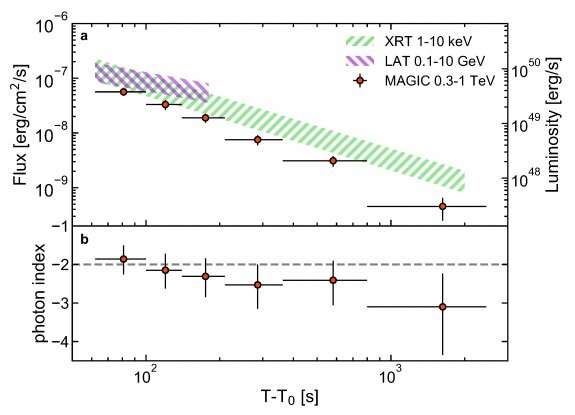#Astronomers detect teraelectronvolt emission from the gamma-ray burst GRB 190114C
“#Astronomers detect teraelectronvolt emission from the gamma-ray burst GRB 190114C”

An international team of astronomers has detected a teraelectronvolt (TeV) emission from a gamma-ray burst designated GRB 190114C. The discovery could improve the understanding of very high energy (VHE) sources in the universe. The finding is detailed in a paper published June 12 on the arXiv pre-print repository.
Gamma-ray bursts (GRBs) are among the most energetic and explosive events in the universe. Although they are mainly short, intense flashes of soft gamma-rays, some last more than approximately two seconds and are known as long-duration GRBs.
At a redshift of approximately 0.42, GRB 190114C is a gamma-ray burst identified as a long-duration GRB in January 2019 by NASA’s Neil Gehrels Swift Observatory and Fermi spacecraft. Observations with Fermi revealed that the event had a duration of almost two minutes, while data from Swift suggested that it lasted about three times longer.
Shortly after the bursts ended, its afterglow emission at various wavebands from 1.3 GHz up to 23 GeV was detected. This triggered follow-up observations of GRB 190114C with the system of two Major Atmospheric Gamma Imaging Cherenkov (MAGIC) telescopes. By analyzing this data, a group of astronomers from MAGIC collaboration found that the observed GRB exhibited emission emission in the TeV band.
“Gamma rays above 0.2 TeV were detected with high significance from the beginning of the observations,” the astronomers wrote in the paper.
MAGIC observations covered the period from about one to 265 minutes since the start of the burst. During this monitoring, the researchers observed gamma rays in the energy range between 0.2 and 1.0 TeV. The flux initially measured at about 80 seconds after the burst started corresponds to apparent isotropic-equivalent luminosity of approximately 30 quindecillion erg/s at 0.3 − 1 TeV. This makes GRB 190114C the most luminous source known at these energies.
According to the paper, light curves of GRB 190114C in the keV and GeV energy bands display behaviour similar to the TeV band, but with a shallower decay slope for the GeV band. This suggests that most of the observed emission is associated with the GRB’s afterglow phase, rather than the prompt phase that typically exhibits irregular variability.
Furthermore, the observations found that even the lowest energy photons detected by MAGIC are significantly above the so-called synchrotron burnoff limit and extend beyond 1.0 TeV. The astronomers noted that this is the first evidence for a new emission component, energetically important, beyond synchrotron emission in the afterglow of a gamma-ray burst. They underlined the importance of this finding for further studies of GRBs.
“The discovery of an energetically important emission component beyond electron synchrotron emission that may possibly be common in GRB afterglows offers important new insight into the physics of GRBs,” the authors of the paper concluded.
More information:
Teraelectronvolt emission from the gamma-ray burst GRB 190114C, arXiv:2006.07249 [astro-ph.HE] arxiv.org/abs/2006.07249
© 2020 Science X Network
Astronomers detect teraelectronvolt emission from the gamma-ray burst GRB 190114C (2020, June 22)
retrieved 22 June 2020
from https://phys.org/news/2020-06-astronomers-teraelectronvolt-emission-gamma-ray-grb.html
This document is subject to copyright. Apart from any fair dealing for the purpose of private study or research, no
part may be reproduced without the written permission. The content is provided for information purposes only.
If you want to read more Like this articles, you can visit our Science category.
if you want to watch Movies or Tv Shows go to Dizi.BuradaBiliyorum.Com for forums sites go to Forum.BuradaBiliyorum.Com


